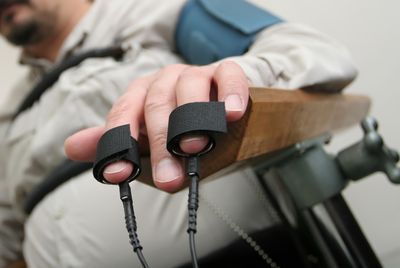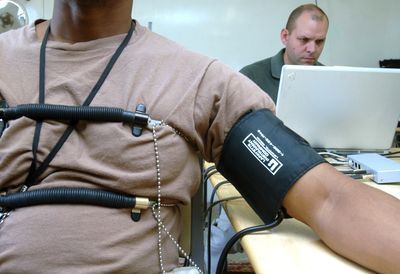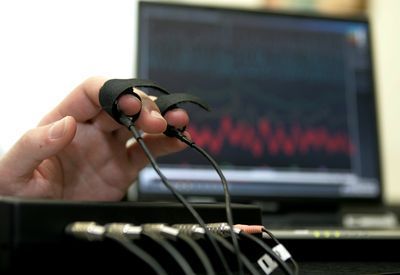Lie detectors: why they do not work, and why the police use them anyway

The FBI checks on a polygraph of all potential candidates for employment in this bureau. If we take into account the Drug Enforcement Agency, the CIA and other agencies, it turns out that approximately 70,000 people a year undergo a polygraph test when applying for a job in US government organizations.
Polygraphs are regularly used by law enforcement agencies when interrogating suspects. In some places they are used to track the behavior of those accused of sex offenses on bail, and some judges allow concluding deals with justice based on the results of a polygraph study of the defendants.
')
And now, what is the most mysterious about all this: the question whether polygraphs are a good way to determine whether a person is lying, has long been given a definite answer. Not are.
“There are no unique psychological signs of deception. There is no evidence that the parameters measured by the polygraph — heartbeat, pressure, sweat, breathing — are related to whether you are telling the truth or not, ”says Leonard Saxe, a psychologist at the University of Brandeis who studies polygraphs. The detailed report of the National Research Council of the United States concluded: "Almost a hundred years of research in the field of scientific psychology and physiology almost does not give reason to expect that tests on a polygraph can show high accuracy."
This is not exactly the latest news. The Sachs report of 1983 , heard by Congress, banned the use of polygraphs in private companies for inspections of employees, and the 1998 Supreme Court decision banned the use of polygraphs in federal courts, due to "the lack of consensus on the reliability of evidence collected using a polygraph."
Still, polygraphs are regularly used in government offices and law enforcement agencies. An obvious question arises: why do they rely on pseudoscience when checking employees and investigating cases?
How to conduct a polygraph test

In the first few decades of the 20th century, American researchers and police investigators developed several variants of polygraphs. It all started with a device that measures pressure, which was then equipped with the ability to measure the galvanic reaction of the skin on the arm (to measure sweating), as well as measuring the speed of breathing and heartbeat. "They took the technology of the XIX century and put them in one box," - said Jeffrey Bunn, author of the book "The machine of truth: the social history of the lie detector" [Geoffrey Bunn: A Social History of the Lie Detector ].
The idea was that these physiological reactions, firstly, can reliably show whether a person is telling the truth or is lying, and secondly, they are beyond the control of a person. But from the very beginning this was not reliable evidence. “There has never been a complete theory of the“ physiology of lies, ”says Bann. “These three dimensions — pressure, sweating, breathing — belong to different physiological systems."
However, in the 1950s and 1960s, investigators developed a widely used verification procedure called “ test questions technique ”. In fact, the investigator mixes control questions, a bit threatening, but not directly relevant (“have you ever stolen anything from your friend?”) With questions directly related to the investigation (“did you commit the robbery on June 17? "). The subject is also constantly reminded that the car can accurately distinguish between truth and lies, and they must answer truthfully.
The idea is that the control questions will mark a certain basic level of anxiety associated with interrogation, since these questions are vague and difficult to answer absolutely truthfully. If a person has not committed a crime, it is considered that the level of his anxiety will be lower when they are asked relevant questions because he will be sure that he is not lying. But if they committed it, then questions will cause an even greater level of anxiety. And all this will be reflected in their physiological reactions.
Therefore, to understand whether someone is lying, you just need to compare his physiological reactions to control questions with the reactions to the main ones. If in the first case the reactions are stronger, they are innocent. If in the second, they are guilty.
What does the test actually measure?

In reality, the polygraph measures only excitement.
“All these physiological dimensions are associated with fear and anxiety,” says Saks. “But sometimes people worry, telling the truth, and they may not worry when they lie.” The more you practice in a lie, the less unrest is associated with it. ”
In other words, a polygraph test can sometimes be correct and sometimes erroneous.
Controlled laboratory tests have shown that tests are usually able to correctly identify a liar with a probability greater than random, but also incorrectly show that many honest people are lying. The National Research Council of the United States concluded that these tests are not perfect either, since people pretend to have committed crimes, and this most likely does not lead to the appearance of real emotions. When charged with a real crime, most people naturally become agitated, even if they are innocent.
To make matters worse, these tests were not conducted on people trained to resist them — using different strategies to trick the test. Experts conclude that polygraph tests are likely to be deceived by trained people - and this seems to be believed by the federal authorities, who have recently been trying to arrest people offering training services for such methods.
In connection with all this, the American Physiological Association does not recommend the use of polygraph tests in investigations or for testing employees. Researches constantly show that polygraphs do not cope with a decrease in cases of relapse among those accused of sexual crimes. The US National Research Council even stated that the excessive faith of federal agencies in the polygraph "poses a threat to national security."

Despite the prohibition of the use of polygraphs by private employers from 1988 and the decision of the court from 1998, according to which test results are not accepted as evidence in federal courts, the law has a lot of workarounds - they are used by federal employers, law enforcement, officials supervising for early released or conditionally convicted persons, and others.
But if there is so much evidence that a polygraph cannot define a lie, why are all these people so eager to use them?
One possibility is to believe in their use as props. Sachs calls this the "interrogation theater." “If the interrogator correctly implements the theater and makes the interrogated believe that his lies can be detected, he may confess,” he says.
Related to this is the belief in the frightening effect of the lie detector: if the person who committed sexual violence believes that he will be regularly examined with the help of accurate tests for lies, then the crime will seem to him a guaranteed ticket back to prison. And for this type of use it is completely unimportant whether the test works or not — the main thing is that it is considered a worker.
But Sachs thinks that in some cases the less cynical factor plays, something that looks more like a myth or religion than science.
“People want to believe in a just world. And in a fair world you can't lie and not get caught, ”he says. - I spoke with some people using a polygraph, and it seems to me that they believe in the accuracy of their actions. Some even say something like: "God gave us this device to make the world a better place."
Source: https://habr.com/ru/post/370519/
All Articles